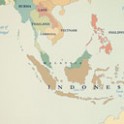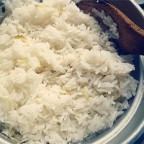My name is Aishah (eye-shah). Welcome to East Malaysia on the island of Borneo. My village is in the Cameron Highlands. Years ago, much of the world’s tin was mined here, but now this area is known for the tea plantations and strawberry farms that cover the valleys like a bright green carpet.
Here in our kampong (kahm-puhng) village, many generations live in a close-knit community. Our two monsoon seasons bring lots of rain so most families build their small wooden houses up on stilts to prevent flooding.
It’s Saturday and I’m going with my family to the night market. I have permission to visit the street vendors with my friends. We head past the brightly colored displays of star fruit, bananas, coconuts and papaya to the lady selling fresh fruit juice. My favorite flavor is mango – yum! Then we stop by the clothing stall and try on colorful sarongs (sah-rahngs), wrapping the pieces of cloth around our waists. Sometimes I wish we could wear these to school. Instead, girls wear uniforms – white shirts with skirts or jumpers.
When we turned 12, my girlfriends and I started wearing elbow-length headscarves like most Malay women. These headscarves cover our hair, ears, and neck and fasten under our chin.Wearing this head covering is part of being Muslim, and being Muslim is a big part of our identity. In school, we learn about Islam every day. My parents send me to religious classes after school where I memorize sections of the Muslim holy book in Arabic and recite prayers. These actions will help us find favor with God.
On Sunday, my older brother and I walk to the park. He joins his friends to play sepak takraw (say-pahk tahk-rah), a game similar to volleyball except that players use their feet, knees, and head to get the ball over the net – no hands allowed! I play hopscotch and watch some younger children flying their kites. Before heading home, my brother takes me to the cultural center. We buy tickets for the shadow puppet performance that is coming to town next month.

Family Activity:
Create your own puppets by drawing simple outlines of boys or girls on poster board. You don’t need to add clothes or facial features because the audience will only see the puppet’s shadow. Cut out the puppets. Use paper fasteners to make the puppet’s arms and legs hinged so you can move them. Hang up a white bed sheet and put a lamp on a table behind it. Now it’s time for the show. Take turns going behind the sheet with your puppets. Hold your puppet between the light and the sheet to make shadows that can be seen by the audience. As you move your puppet, tell three things you learned about the Malay people.
Pray:
• Pray that heads of Malay families will come to know Jesus as savior, opening the way for entire extended families to hear about Him.
• When Malay become Christians, they are treated very badly by their Muslim family and neighbors. Pray that these new believers will trust in God to protect them and give them courage to share Jesus with their friends and relatives.
Malay
Nasi Lemak
(nah-see luh-mahk)
Southeast Asia
Preparation Time: 30 minutes | Serves: 8-10
Ingredients
- 2 ½ cups long-grain rice
- 2 ½ cups coconut milk (Asian section)
- 2 ½ cups water
- 4 hard boiled eggs
- 1 large cucumber
- mild salsa
- nuts (optional)






